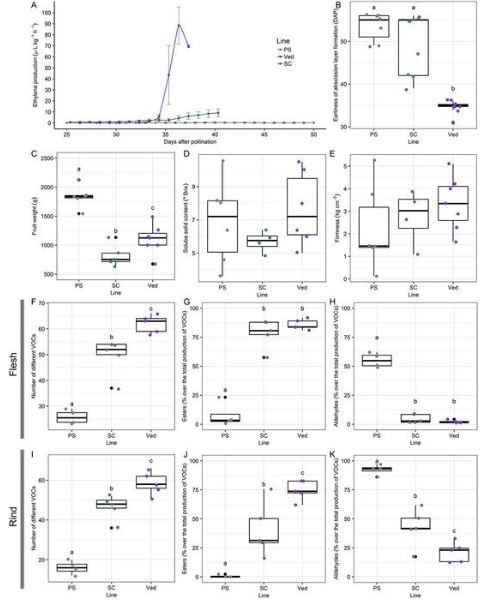December 20, 2023

Phenotypic evaluation of the three parental lines PS, SC and Ved used in the study, showing: A) ethylene production (ETH), B) earliness of abscission layer formation (EALF), C) fruit weight (FW), D) soluble solid content (SSC), E) flesh firmness (FIR), F) diversity of VOCs in flesh, G) percentage of esters over the total amount of VOCs in flesh, H) percentage of aldehydes over the total amount of VOCs in flesh, I) diversity of VOCs in rind, J) percentage of esters over the total amount of VOCs in rind, K) percentage of aldehydes over the total amount of VOCs in rind. Letters represent significant difference between groups (p-value <0.05).
Credit: Horticulture Research
Fruit development, particularly ripening, is a crucial and energy-intensive stage in plant life, vital for both human consumption and plant breeding. It involves biochemical and physiological transformations, such as cell wall softening and pigment accumulation. Melon (Cucumis melo L.), with both climacteric and non-climacteric varieties, is gaining attention as a model for studying fruit ripening processes, aided by genetic resources like Recombinant Inbred Lines and sequenced genomes. Recent research has identified key Quantitative Trait Loci (QTLs) influencing melon ripening, such as ETHQB3.5, ETHQV6.3, and ETHQV8.1. These QTLs affect ethylene production and other ripening characteristics. However, the interaction among these QTLs and their collective impact on melon ripening and fruit quality remains an unexplored area of research.
In June 2022, Horticulture Research published a research article entitled by “Modulating climacteric intensity in melon through QTL stacking”.
The parental lines used in this research showed varied ripening behaviors and fruit qualities. The PS variety produced a low ethylene amount, indicating a non-climacteric nature. Songwan Charmi (SC), though non-climacteric, exhibited some climacteric traits, such as aroma production. Védrantais (Ved, climacteric) displayed typical climacteric fruit ripening, with a sharp ethylene peak and noticeable climacteric traits. In terms of fruit quality, PS produced the largest fruits, while SC had the smallest. However, no significant differences were observed among the lines in terms of soluble solid content or firmness. The aroma profile analysis revealed that Ved accumulated the most volatile organic compounds (VOCs), followed by SC, and PS the least. The diversity of VOCs was also highest in Ved. The study then developed Introgression Lines (ILs) in the PS background with various combinations of the QTLs. Analysis showed that these ILs influenced climacteric symptoms such as earliness of aroma production and abscission layer formation. The ethylene production in these lines varied, with those containing more than one QTL showing earlier and higher ethylene production. ETHQV6.3 and ETHQB3.5 have significant effects on the earliness and sharpness of ethylene peaks, respectively. Although ETHQV8.1 has no significant effect on ethylene peaks, it enhances the effects of the other two QTLs. The ILs also demonstrated significant increases in total volatiles production, particularly in esters, and varied in their production of other minor compounds like alcohols and terpenes. Interestingly, while the ILs generally mirrored Ved in floral and fruity aroma compounds, they did not significantly alter other fruit quality traits like weight, sugar content, or firmness.
In conclusion, this study successfully combined three Quantitative Trait Loci (QTLs) - ETHQB3.5, ETHQV6.3, and ETHQV8.1 - in the non-climacteric melon variety Piel de Sapo to modulate climacteric ripening and associated traits and elucidated the roles and interactions of them. The approach demonstrates how genetic manipulation can finely tune fruit characteristics, paving the way for developing melons with varied shelf lives and aromatic qualities, enhancing their commercial and consumer appeal.
References
Authors
Miguel Santo Domingo1, Lorena Areco1, Carlos Mayobre1, Laura Valverde1, Ana Montserrat Martín-Hernández1,2, Marta Pujol1,2,* and Jordi Garcia-Mas1,2,*
Affiliations
1Centre for Research in Agricultural Genomics (CRAG) CSIC-IRTA-UAB-UB, Edifici CRAG, Campus UAB, Bellaterra, 08193 Barcelona, Spain
2Institut de Recerca i Tecnologia Agoralimentàries (IRTA), Edifici CRAG, Campus UAB, Bellaterra, 08193 Barcelona, Spain
About Marta Pujol & Jordi Garcia-Mas
Marta Pujol: Marta Pujol is an IRTA researcher in the Plant and Animal Genomics Program of the Center for Research in Agricultural Genomics (CRAG) since 2006. Much of her work is based on mapping agronomical important traits, both under monogenic and quantitative inheritance in 7 species: melon, cucumber, watermelon, zucchini, tomato, pepper and eggplant. She also works with TILLING platforms of melon, cucumber, eggplant and tomato searching mutants in genes of agronomic interest. Her public research is oriented to deciphering the genetics of ripening, fruit quality and disease resistance in melon.
Jordi Garcia-Mas: He is a researcher of the Center for Research in Agricultural Genomics (CRAG). His research focuses on developing genomic tools to characterize important agronomic traits in melon and related species 1. Analysis of variability in melon using re-sequencing of melon germplasm. 2. Characterization of QTLs for melon fruit ripening. The aim is to understand the molecular basis of the non-climacteric ripening found in the inodorus melon genotypes. 3. Characterization of QTLs for accumulation of sugars in the melon fruit.